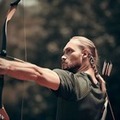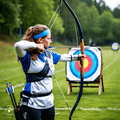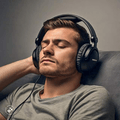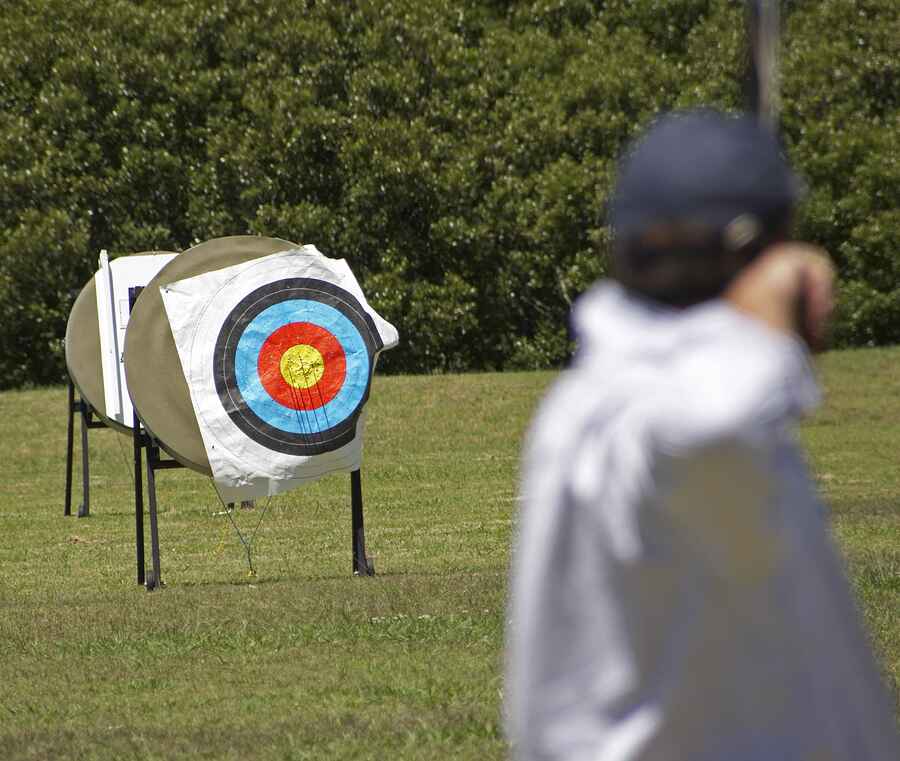Overcome Archery Target Panic & Master Performance
By Craig Townsend
Clinical Hypnotherapist, Mental Trainer & Founder of
NeuroFrequency Programming™
A groundbreaking multi-layered method that blends advanced mind techniques with various brainwave frequencies to unlock deeper potential, dissolve limiting patterns, and rewire your subconscious for lasting transformation. Learn more about NeuroFrequency Programming™ and the Multi-Track Transformation System™ →
Updated: December 2025

With most archers I’ve worked with over the past two decades, the fix for target panic lies at the very control center of performance - your subconscious Your subconscious is the powerhouse of peak performance, controlling all bodily movement, storing your training experience and muscle memory, and guiding your body with effortless efficiency and precision. Estimated to be 275,000 times more powerful than the conscious mind [University of Pennsylvania] Estimated to be 275,000 times more powerful than the conscious mind [University of Pennsylvania] .
So if you experience any of these...
- Target panic
- Anxiety when holding in the middle
- Shooting poorly under pressure
Mental training is the key - even if your goal is overall improvement, rather than specific issues.
Better still, you can customize it to suit your personal situation and needs.
Mental mastery is no different from mastering physical skills - you must train at the inner gym. Developing unshakable belief, focus under pressure, and pre-programming performance brings endless rewards.
The Moment Between Draw and Release
In archery, everything depends on a few seconds of absolute control. Your draw is smooth. Your anchor is perfect. Your sight picture is clear. And then, in that critical moment before release, your mind either trusts your process or sabotages it with doubt.
Here is what separates archers when scores matter: Two competitors step to the line for the final round. Both have practiced their form thousands of times. Both know their equipment perfectly. Both have the physical capability to shoot tens.
The first archer settles into their anchor with complete calm. Their sight floats naturally to center. They hold without tension. The release happens automatically when their subconscious signals readiness. The second archer? Anxiety floods in the moment they reach full draw. Their muscles tighten. Their sight won't settle on center. They either punch the trigger early or freeze, unable to execute. That mental interference shows up as arrows scattered across the target instead of grouped in the gold.
This is not about form or equipment. This is about whether your subconscious trusts your shot sequence or creates involuntary tension that disrupts it. Your bow arm steadiness, your back tension, your release timing - all controlled by what happens in your mind during those critical seconds.
In practice, your shot flows naturally. No tournament pressure. No scores being recorded. Your anchor feels solid. Your sight settles easily. Your release is smooth. Everything works because your subconscious is not creating interference with fear or doubt.
But in competition? Your subconscious suddenly registers threat: scores matter, people watching, fear of repeating past mistakes. That mental tension creates involuntary physical responses - your bow arm trembles slightly, your anchor feels unstable, your release becomes rushed or frozen.
Archers with mental training keep their subconscious calm regardless of the stakes. The bigger the competition, the more their shot sequence runs on autopilot. Their anchor stays solid. Their sight floats naturally. Their release happens cleanly. They shoot their best scores when it matters most - not because they concentrate harder, but because their mind does not create the involuntary tension that disrupts execution.
This is why archers with technically weaker form sometimes outshoot more skilled competitors under pressure.
Today, I’ll show you powerful techniques you can use from home. We’ll explore both traditional methods and the latest fast-track techniques used by elite competitors to access peak performance and overcome barriers.
As much as people try, issues like target panic (an involuntary action), much like “the yips” in golf, are often called a form of self-sabotage - and they lie outside your conscious control. They cannot be overcome with sheer practice and determination.

These involuntary actions may include locking below the middle of the bullseye, struggling to bring the sight to the middle, or shooting prematurely.
This is a form of inner anxiety that can sabotage performance through involuntary muscle contraction, reducing control when aiming before release.
Target panic is often compared to the “yips” in golf - an involuntary response that cannot be solved through conscious effort, motivation, or extra practice. The solution lies in working with the subconscious.

Mental training allows archers to relax, bring their sight to the middle of the target, and calmly hold it there without anxiety while executing their shot.
This lets you reprogram the subconscious “software” controlling performance, including muscle memory - enabling you to hold the bow steady, effortlessly hold center, and see the target with eagle vision.
When your performance flows directly from the subconscious, it runs on instinctive autopilot - a mental state often called “the Zone The Zone is the peak performance state where your body runs directly from the subconscious. Movements flow naturally, distractions fade, and effort feels effortless as you perform at your absolute best. .”

Advantages / Uses of Mind Training
- Overcome and reprogram target panic (and other self-sabotage) at the root.
- Pre-program your shot sequence using visualization to reinforce success.
- Remain cool and focused while executing your shot.
- Reinforce steady aim through hypnotic suggestion.
- Increase inner belief and self-confidence.
- Manage self-doubt and negative self-talk before and during tournaments.
- Deepen concentration and ignore distractions.
- Compete at the peak of your powers more consistently.
Mental training has been proven to work effectively for these challenges. You can even start with techniques like mental imagery, where you vividly replay your strongest performances to create a powerful blueprint for success.
To make a real impact, this mental reinforcement needs to be practiced regularly, building a deep subconscious foundation for flawless, pressure-proof performance.
Implementing & Mastering These Techniques at Home
 |
|---|
For generations, athletes have relied on powerful techniques like visualization to gain a competitive edge. Now, with advancements in modern technology, these techniques have become even more sophisticated
I will outline some examples for you shortly, which you can practice at home (as effective do-it-yourself programs are what most people are asking for).
I have outlined the various options below to cater to different levels, so you can choose the best path you'd like to explore..
Training Options - For Different Standards, Levels & Skill Sets
Depending upon your level of experience and expertise, there are two distinct approaches to mental preparation:
1. Accelerated Techniques (audio MP3 subconscious training for faster results) or
2. Manual Methods (free self-guided options listed below).

|
|---|
Accelerated Techniques
Intermediate & Advanced Competitors
Designed to achieve results in as little as 4–6 weeks that might otherwise take up to 12 months with traditional training.
If you prefer to skip the long hard manual work of mental training (which I also outline further below), then the easiest step to accelerate your progress is to get the fast-track audio program below – developed from decades of coaching elite athletes, combining neuroscience with hypnotic techniques. Just $29.
These audios embed everything straight into your subconscious, so no manual repetition is needed.
Fast-Tracking Your Results
Mind Training for Archery
by Craig Townsend (Dip. Clin. Hyp)
MP3 Download $29.95
Incl. Bonus: Sleep Subliminal (value $30)
1 Year Unconditional Warranty
Or the ultimate solution for the most serious competitors...
Personalized Mind Training
Mind Programs for Advanced & Elite Competitors
The next-level of training is to check out NeuroFrequency Programming - a system of customized
theta-level
Theta brainwaves (4–8Hz): Unlocks heightened creativity, mental clarity, and subconscious alignment - ideal for accelerated learning, focus, and peak performance.
mental training recordings, personalized to your exact needs, training, schedule, mindset, and competition challenges - to deal with confidence, focus, resilience, and overcoming nerves or lack of belief.
This shifts your mind quickly into a higher gear - integrating your training deeply at the software level, to create strong and lasting improvements in performance, mindset, and results. More details below.
Manual Methods
Developing Competitors
Of course, if you are just starting out, time is not an issue, and quick turnaround on results is not urgent - you can always begin by practicing the various mental exercises manually - and you can always progress to the next level later on - which will combine these and other techniques simultaneously, to further accelerate your results. (see below).
For those who can dedicate time to regular to regular practice and reinforcement, I have provided a selection of options and info below you can work through, and explore further.
(if you have further questions - simply drop me an email)
 |
|---|
1. Embedding Positive Core Beliefs
This exercise, called a contemplation, embeds powerful new core beliefs within your subconscious, as these enormously influence performance.
Your beliefs - weak or strong - ultimately determine your results - your susceptibiity to unconscious self sabotage, and how far your potential can develop. They are the dominating force - more powerful than motivation, talent, ability, fitness, power, etc.
These are your 5 Core Beliefs list to instill, below. Focus on each point in the list for 30 seconds daily, thinking of positive thoughts related to the topic and reasons why it's true for you.
Do this until the reasons are true for you.
2. I have done the training and believe in my ability.
3. I consistently execute my shots with accuracy and precision.
4. I block out all distractions and remain fully present in the moment as I execute my shots.
5. I easily adjust to changing conditions, and thrive under pressure.
 |
|---|
2. Visualization Exercises
Needless to say, the initial and primary visualization should be of yourself competing at your absolute peak of your performance - with as much, or as little, detail as you wish - and importantly - imagine experiencing the emotional joy of success afterwards - which is the opposite emotion of stress.
Do this each day, while in a relaxed state (directly before or after sleep are excellent times), and ensuring you use all your senses - ie. ensure the images are vivid, realistic, present-tense, positive, and without any external distractions.
If, like most others, you find your motivation to manually do these exercises eventually peters out altogether - just make sure you do this one exercise.
While the results wont be as quick as using the audio recordings, slowly but surely this will bring about improvements, so be patient. As you progress in your development, consider integrating the following aspects to enhance your mind's capacity to visualize flawless performance.
As there are literally hundreds of different ways you can use imagery for various different purposes, I have included some options you can experiment with later on.
But for now, keep to the basics, and make sure you practice regularly.
*
Mental Imagery Examples.....
- Focus on your breathing - creates better control of your body and aim. Take deep breaths, and exhale slowly, allowing your body to relax and focus on the shot.
- Imagine the perfect shot - Picture in your mind's eye what a perfect shot would look like - hitting the bullseye, and your form being perfect.
- See the path of the arrow - Picture the path that it will take in your mind's eye. Imagine it traveling towards the target, and embedding itself in the bullseye.
- Hitting the target - the feeling of satisfaction and accomplishment that comes with a successful shot.
- Wind direction - Picture the wind blowing and imagine how it will affect your shot. This expands your ability to compensate for wind resistance.
3. Affirmations for Performance
You can also manually recite a mantra over and over again silently in your mind, which is a manual auditory method which can be targeted towards specific uses - plus work great to drown out nagging negative thoughts during performance.
Note: Ensure you use a great deal more repetition to create the necessary reinforcement, seeing these will be recited at the conscious, rather than subconscious, level. A manual way to get around this can be reciting mantras in the shower, which relaxes the mind and body.
Some examples below.. ensure the statements are positive, present-tense, and with no hidden or reverse negatives.
"I have a steady hand, and aim with precision." - believe in your abilities to aim and shoot accurately.
"I focus and tune out distractions." - helps you stay in the zone and avoid getting distracted by external factors.
"I take my time with each shot." - rushing leads to poor accuracy, and this reminds you to take your time and execute each shot deliberately.
"I trust my instincts and aim with confidence." - Confidence is essential, and can help you trust your instincts and aim without hesitation.
"I have a strong and consistent draw." - builds confidence in your technique in executing a smooth and consistent draw every time.
"I have a steady anchor point." - the point at which you draw the bowstring back to, and can improve your accuracy.

Listen...
* Audio – “The Power of Visualization & Belief”
Craig Townsend explains how these transform performance.
Click the “Play” symbol to start the audio.

